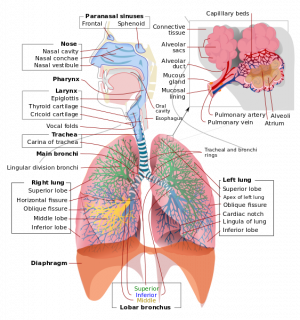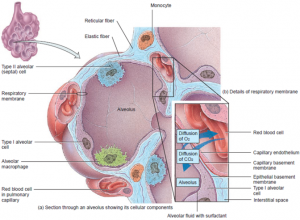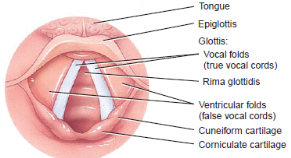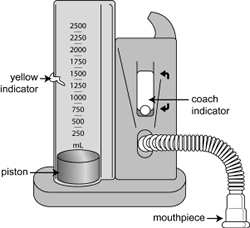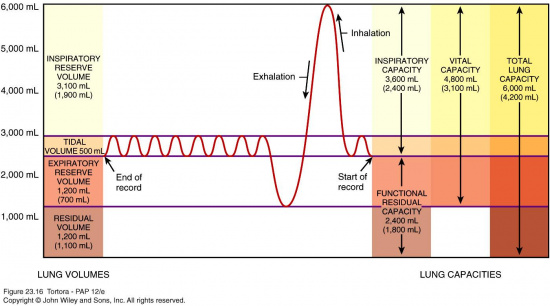Anatomy/Respiratory System
The respiratory system is a topic of the event Anatomy. It will come into rotation in 2023, along with the Immune System and Digestive System.
Functions
- Protection - enables protective and reflective non-breathing air movements such as coughing and sneezing
- Ventilation - the exchange of gases
- Respiration - supply oxygen and remove carbon dioxide from blood as it circulates through the body (external respiration, not cellular respiration)
- Regulating blood pH - the more carbon dioxide in the blood stream, the lower the pH of the blood.
- Speech and other vocal sounds
Mechanics
The Respiratory system is controlled in mammals by the diaphragm muscle.
When the diaphragm relaxes, the thoracic cavity decreases in size. However, when the muscle contracts, it pulls downward, adding size to the thoracic cavity. While this happens, the intercostal muscles pull upwards on the ribcage, adding more space to the thoracic cavity. When the diaphragm relaxes, it pushes upward on the lungs, along with the intercostal muscles pushing downward on the ribcage. These muscles decrease the volume while increasing their internal pressure. When the diaphragm contracts, the lungs gain volume and lose pressure, causing a partial vacuum. Having no choice at this point but to follow the laws of nature, air follows the pressure gradient and rushes into the lungs.
There are two main breathing patterns: quiet breathing and forced breathing.
In quiet breathing, muscles contract voluntarily to let air in the lungs (an active process), but muscles relax when you exhale (passive process).
In forced breathing, muscles contract voluntarily in both inspiration and expiration.
Parts of the Respiratory System
The upper respiratory system consists of the organs from the nostrils to the pharynx, in order of where the air passes. The lower respiratory system stretches from the top of the trachea to the diaphragm.
- Air is taken in through the nose.
- The nostrils are one of two places where air enters and exits respiratory system. It has hair to trap dirt, dust particles, and bacteria.
- The nasal septum separates the nasal cavities.
- Three bones of the nasal conchae provide more surface area inside the nose, as they are rolled up like conch shells.
- The respiratory mucosa lines the nasal cavity and has tiny cilia that move dirty mucus toward the outside of the nostrils.
- Lacrimal glands secrete tears that flow across the eye's surface and drain through the openings in the lacrimal puncta (more commonly known as the corner of the eye) into nasolacrimal ducts and nasal cavities. This is why your nose runs when you cry.
- Sinuses are air spaces in the skull that lighten the weight of the head. They open into nasal cavities to receive air and are lined with mucous membranes.
- Air passes through the pharynx on its way to the lungs.
- The area between the nasal cavities and the pharynx is called the choana
- The nasopharynx is the top part of the throat where the nasal cavities drain.
- The hard palate can be felt at the roof of the mouth. It is a bony plate that separates the mouth (oral cavity) from the nose (nasal cavities).
- The soft part on the roof of the mouth, nearer the back of the throat, is the soft palate.
- Beyond the soft palate itself is the nasopharynx. The soft palate moves backward when you swallow so that the nasopharynx is blocked, ensuring you don't literally inhale your food. (When you laugh while eating, the soft palate begins to move back but is thrust forward suddenly, sending the contents of your mouth to your nasal cavities to fly out of your nose.)
- The oropharynx is in the back of the mouth.
- It extends from the uvula to the level of the hyoid bone.
- It is also the location of the epiglottis, a cartilage structure that guides materials passing through to either the trachea or esophagus, depending on what the material is. It covers the glottis and blocks food from getting into the larynx when swallowing.
- The laryngopharynx is the lower part of the throat adjacent to the larynx.
- The larynx, more commonly known as the voice box, is a triangular structure that produces your voice. When you aren't speaking, your voice box opens, and when you are speaking, your voice box closes. This is why you have limited breath to talk, and you have to breathe consistently, especially when you are singing or playing an instrument.
- .*** At the apex of the triangle is the thyroid cartilage, better known as the Adam's apple.
- At the top of the larynx is the glottis, which is the opening through which air passes.
- The vocal chords are inside the glottis. They gather mucous membranes that cover ligaments. Pushing more air over the vocal chords makes the sound (singing, speaking, etc.) louder, while tightening the vocal chords narrows the glottis, making a higher-pitched sound.
- The trachea (more commonly known as the windpipe) is a tube that runs from the larynx to just above the lungs.
- It divides into two large branches behind the sternum called primary bronchi that enter each lung.
- Both the trachea and the bronchi are made of smooth muscle and cartilage, allowing airways to contract and expand.
- The lungs are large paired organs within the chest cavity on either side of the heart. They are protected by the rib cage.
- The lungs sit atop the diaphragm, a powerful muscle fixed to the lower ribs, sternum, and lumbar vertebrae.
- The heart sits in a cavity between the two lungs called the mediastinum.
- The lungs are separated into lobes (three for the right lung, two for the left), then segments, then lobules.
- The lungs are sealed off from the inside surface of the thoracic (chest) cavity by two layers of pleurae. The visceral pleurae cover the outer surface of the lungs and the parietal pleurae cover the inside surface of the thoracic cavity. The pleural cavity is the potential space between the two pleurae and contains a lubricating fluid called intrapleural fluid.
- Because the pressure between the two pleurae is about 4 mmHg (milimetres of mercury) lower than that of the atmosphere and the inside of the lungs, the outer surfaces of the visceral pleurae are always "stuck" to the internal surface of the parietal pleurae, and the lungs are kept inflated in this way.
- After the primary bronchus enters the lung on each side, it splits into secondary and tertiary branches called bronchi.
- Tertiary bronchi divide into smaller branches called bronchioles. At the end of the smallest bronchioles (the terminal bronchioles) are grape cluster-like structures called alveolar sacs, and each sac contains alveoli (the individual grapes). The alveoli's walls are composed of a simple squamous epithelium designed to facilitate rapid diffusion and elastic tissue. Each alveolus is wrapped with capillaries.
- The interface of simple squamous epithelium of the alveolus and pulmonary capillary is called the respiratory membrane (the single, fused boundary between the alveolar and pulmonary capillary lumens), and it is here where gas exchange takes place. Blood vessels criss cross each alveolus, providing a large surface area for gas exchange between the alveoli and pulmonary capillaries.
- The respiratory membrane is also where carbon dioxide is eliminated. It flows into the air in your lungs and you breathe it out.
- The diaphragm is a dome-shaped muscle separating the thoracic (chest) cavity from the abdominal (belly area) cavity. It contracts downward (flattens) during inspiration, increasing the volume of the thoracic cavity, and inflating the lungs. Consequently, air rushes into the lungs following the pressure gradient (since air pressure in the lungs is now lower than atmospheric air pressure). When expiring, it simply relaxes, and the elasticity of the lungs pushes air out again.
- The motor phrenic nerves contract and relax the diaphragm.
- The diaphragm can also exert pressure on the abdominal cavity, helping expel vomit, feces, and urine.
Pulmonary Volumes and Capacities
Pulmonary volumes are measured by a spirometer. The normal breathing rate is 12-20 cycles per minute, which totals to 17000+ breaths per day.
A spirogram is a graphical representation of the respiratory volumes captured by the spirometer. Spirograms can be indicative of certain respiratory disorders or of healthy lung function.
Pulmonary Volumes
- Tidal Volume (TV)- the volume of air inspired or expired in a regular breath (500 mL)
- Inspiratory Reserve Volume (IRV)- the maximum amount of air that can be inspired after breathing in normally (3000 mL)
- Expiratory Reserve Volume (ERV)- the maximum amount of air that can be expired after breathing out normally (1100 mL)
- Residual Volume (RV)- the amount of air still remaining in the respiratory passages and lungs after a maximum expiration (1200 mL)
Pulmonary Capacities
- Functional Residual Capacity (FRC)- ERV + RV
- Inspiratory Capacity (IC)- TV + IRV
- Vital Capacity (VC)- IRV + TV + ERV
- Total Lung Capacity (TLC)- IRV + ERV + TV + RV (normally 6000mL in a healthy male adult)
- Pulmonary Ventilation- TV * respiratory rate (the total volume of gas entering the lungs per minute)
- Alveolar ventilation = (TV - dead space) * respiratory rate (the volume of gas per unit time that reaches the alveoli, the respiratory portions of the lungs where gas exchange occurs.)
- Dead space ventilation = dead space * respiratory rate (the volume of gas per unit time that does not reach these respiratory portions, but instead remains in the airways [trachea, bronchi, etc.])
Control of Breathing
Unlike digestion, pupil contraction, and the beating of the heart, breathing can be controlled both unconsciously and consciously. Few other actions are like this (blinking and coughing are two other examples). When an individual is not actively thinking about breathing, such as when the body is at rest, the body begins to unconsciously regulate air intake. When not being actively controlled, breathing is controlled by the brain stem, specifically the medulla oblongata and pons. The brain stem will automatically regulate breathing as needed by the body. For instance, when exercising, the body needs ATP for muscle contraction to occur. When strength training, the body enters the zone called anaerobic exercise. This triggers anaerobic metabolism, which causes a buildup of lactic acid in the body. This lowers blood pH, which can be fatal. The brain stem then increases the rate of breathing.
However, when performing activities such as pranayama yoga, the individual is consciously deciding when to breathe. Conscious breathing control comes from the cerebral cortex, though this control can be overridden by chemoreceptor reflexes.
High altitude
High altitude causes decrease in the amount of oxygen. With high altitude it can lead to hypoxia. Hypoxia has effects on body weight, muscle structure and exercise capacity, mental functioning, and sleep quality. The most important is hyperventilation which is achieved by hypoxic ventilatory response of the peripheral chemoreceptors. Hyperventilation results in increase in arterial carbondioxide concentration. Altitude also affects sleep and cardiac output, which is the other determinant of oxygen delivery. When exposed to high altitude, the resting pulse rate increases rapidly, but with acclimatization, heart rate and cardiac output tend to fall. Another important component that leads to decrease in cardiac output is the reduction in the stroke volume with acclimatization. The levels of CO2 in the blood can drop and this can switch off the drive to breathe. After the body senses a further drop in O2 levels breathing is started again. Periodic breathing is a result from instability in the control system through the hypoxic drive or the response to CO2.
Gas Exchange and Transport
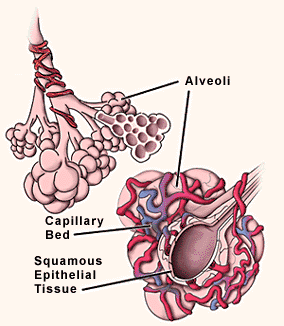
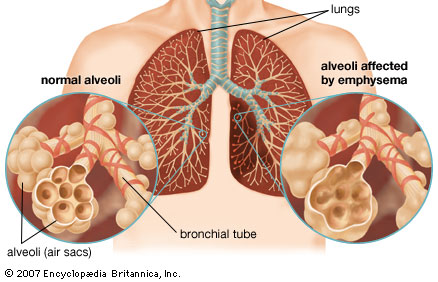
|
Gas exchange
- Oxygen in air dissolves into fluid lining the alveolus and diffuses through alveolar wall and capillary wall.
- Oxygen enters blood plasma inside capillary. Gas exchange occurs in the capillary beds.
- Oxygen binds to oxyhemoglobin in red blood cells.
- Carbon dioxide diffuses out of blood plasma and into air in alveolus.
- Oxygenated blood leaves heart and circulates through capillaries to tissue.
- Red blood cells arrive at tissue, rich in oxygen that binds to the hemoglobin in the tissue.
- Oxygen leaves hemoglobin in red blood cells and diffuses across blood capillary walls and into tissue cells.
- Carbon dioxide diffuses out of tissue into blood plasma, which carries red blood cells into lungs. Completely dissociated hemoglobin enters the lung in red blood cells ready to be oxygenated.
Transport of gases in the blood is essential to life. The gases are carried in the blood in one of two ways: in the blood plasma or combined with hemoglobin.
Diseases of the Respiratory System
Acute Rhinitis
Also known as the common cold. The common symptoms are a runny nose, wheezing, teary eyes, and impairment of smell. It is caused by bacterial/viral infections of the nose as well as inhaled irritants.
Asthma
Asthma is caused by inflammation in the airways. When an asthma attack occurs, the muscles surrounding the airways become tight and the lining of the air passages swells. Childhood asthma occurs more frequently in boys than in girls (the young male's airway size is smaller when compared to female's airway, until around age 20, when ratio of asthma between men and women is roughly the same). It is also caused by a genetic predisposition and general sensitivity (40-50% of children with eczema develop asthma). The common triggers are generally the same as those of allergies: Animals, dust, changes in weather (most often cold weather), chemicals in the air or in food, exercise, mold, pollen, respiratory infections, stress, tobacco smoke, aspirin & other nonsteroidal anti-inflammatory drugs (NSAIDs).
Symptoms include a cough with or without sputum production, pulling in of the skin between the ribs when breathing, shortness of breath that worsens with exercise or activity, wheezing, abnormal breathing pattern (expiration is 2x as long as inspiration), apnea, and chest pain or tightness.
The goal of treatment is to avoid the substances that trigger symptoms and control airway inflammation. There are two basic kinds of medication: Control drugs to prevent attacks (take them daily even if you feel fine) and quick-relief “rescue” drugs for use during attacks (work fast to control symptoms; take them when you are coughing, wheezing, having trouble breathing, just before exercise, or during an attack; usually an inhaler).
Chronic Obstructive Pulmonary Diseases (COPD)
COPDs are very common lung diseases. The 2 primary forms of COPD are chronic bronchitis and emphysema; most sufferers have a combination of both conditions. COPD diseases are characterized by a gradual (and irreversible) decrease in the ability to push air out of the lungs due to decreased lung compliance and elasticity. Affected individuals also experience labored breathing, called dyspnea. COPDs can be caused by smoking (the best form of prevention is not smoking), but can also be caused by rare genetic mutations or exposure to airborne irritants.
In chronic bronchitis, the bronchi become inflammed, and goblet cells produce unusually high amounts of mucus. This increases airway resistance and therefore gas exchange and pulmonary ventilation are impaired.
Emphysema
Emphysema is a disease in which lung tissue and alveolar walls are destroyed, decreasing the surface area available for gas exchange in the alveoli. The enlarged alveoli also damage pulmonary capillaries, increasing resistance to blood flow and forcing the right ventricle of the heart to work harder and enlarge due to the strain. The lungs eventually lose their elasticity, forcing the affected individual to use accessory respiratory muscles (intercostals and abdominal muscles) to breathe. As a result, emphysema patients have labored breathing moreso than chronic bronchitis patients. Also, bronchial airways open during inspiration but collapse during expiration, trapping air in the alveoli (creating alveolar dead spaces) and hyperinflating the lungs. This condition causes the affected individual's chest to seem "inflated," hence the appearance is called "barrel chest."
Cystic fibrosis
A life-threatening disease passed down through families that causes thick, sticky mucus to build up in the lungs, digestive tract (especially the pancreas), and other areas of the body. It is one of the most common chronic lung diseases in children & young adults. The average life span of someone afflicted with cystic fibrosis is 37 years.
Caused by a defective gene, it results in life-threatening lung infections and serious digestion problems, and may also affect the sweat glands. Millions of Americans carry the defective CF gene, but do not have any symptoms, because a person with CF must inherit two defective CF genes - one from each parent (1 in 29 white Americans have the CF gene). CF is the most common, deadly inherited disorder affecting Caucasians in the US and is more common among those of Northern or Central European descent. Most children with CF are diagnosed by age 2.
Symptoms include fever, increased coughing and shortness of breath, loss of appetite, increased sputum, and sinus pain/pressure caused by infection or polyps.
There is no cure, but treatment includes antibiotics to prevent and treat lung and sinus infections, inhaled medicines to help open the airways, DNAse enzyme therapy to thin mucus & make it easier to cough up, lung transplants in some cases, and oxygen therapy. It can also be relieved by avoiding smoke, dust, dirt, fumes, household chemicals, fireplace smoke, & mold or mildew, clearing or bringing up mucus or secretions from the airways (1-4x/day), drinking plenty of fluids, and exercising 2-3 times a week. There is no prevention, but the gene may be detected with screening.
Hypoxia
Hypoxia is a condition where the whole body or a certain region of the body is deprived of oxygen. The classic symptom of hypoxia is cyanosis (skin turning blue), but it is not characteristic of all cases of hypoxia and is usually visible only in fair-skinned individuals. Treatment differs by type of hypoxia, of which there are several:
- Anemic hypoxia: characterized by an abnormally low number of red blood cells (RBCs) in the blood or RBCs with too little hemoglobin (Hb).
- Ischemic hypoxia: characterized by an abnormal blood flow due to partial or complete blood vessel blockage.
- Histoxic hypoxia: characterized by the inability of body cells to metabolize oxygen even though adequate amounts of it are delivered. This type of hypoxia is caused by metabolic poisons (those that mess with cell metabolism), a common one being cyanide.
- Hypoxemic hypoxia: characterized by abnormally low partial pressures of oxygen in the blood. Most commonly, it is caused by breathing in air which contains too little oxygen. Carbon monoxide poisoning is a special type of hypoxemic hypoxia. Carbon monoxide (CO) displaces oxygen in RBCs very easily since the affinity of hemoglobin for carbon monoxide is about 200 times greater than that for oxygen. CO poisoning does not produce the usual symptoms of hypoxia. Instead, the affected individual experiences headache and confusion. This condition is treated using hyperbaric therapy or by breathing pure oxygen until the CO has cleared the the body.
Oxygen Toxicity
Oxygen Toxicity is a result from breathing molecular (pure) oxygen at high pressures (such as from oxygen tanks in scuba diving) for a considerable period of time. Oxygen toxicity can affect the central nervous system and pulmonary functions.
Lung Cancer
Cancer of the lungs is the leading cause of cancer deaths. Symtoms of lung cancer include a constant cough, shortness of breath, and infections such as bronchitis and pneumonia. Treatments (not cures) include chemotherapy, surgury, and radiation therapy.
Laryngitis
Laryngitis is inflammation of the vocal folds. This is usually caused by viruses.
Pneumonia
Pneumonia is an infection of the lung. Community-acquired pneumonia is ordinary pneumonia; hospital-acquired pneumonia is acquired in a hospital. It is a common illness that affects millions of people each year in the United States.
It can have multiple causes: Bacteria (the most serious and common cause – common kinds are Streptococcus pneumoniae (pneumococcus), Legionella pneumophila, Mycoplasma pneumoniae, Chlamydophila pneumoniae (atypical/walking pneumonia)), viruses (esp. in infants & young children), and fungi (Pneumocystis jiroveci (immune-compromised)). Symptoms include a cough (with some pneumonias you may cough up greenish or yellow mucus, or even bloody mucus), fever (mild or high), shaking chills, shortness of breath, confusion (esp. in older people), excess sweating and clammy skin, headache, loss of appetite, low energy, fatigue, and sharp or stabbing chest pains.
It can be treated with IV fluids and antibiotics, oxygen therapy, regular antibiotics, humid air, and deep breathing. Precautions one can take are hand-washing, not smoking, and vaccinations.
Sleep apnea
Sleep apnea is when breathing repeatedly stops and starts while sleeping.
There are two main types (complex sleep apnea is the combination of both): Obstructive sleep apnea (the more common form, which occurs when throat muscles relax) and central sleep apnea (which occurs when the brain doesn't send proper signals to the breathing muscles).
Obstructive sleep apnea is caused by the muscles in the back of the throat supporting the soft palate, uvula, tonsils, and tongue relax, narrowing or closing the airway during inspiration. Many people with this type of sleep apnea think they sleep well all night.
Central sleep apnea occurs when the brain fails to transmit signals to breathing muscles and is most commonly caused by heart disease (it can also be, less commonly, caused by a stroke). Patients with central sleep apnea are more likely to remember waking up than those with obstructive.
Complex sleep apnea is caused by an upper airway obstruction like obstructive, but patients also have problems with the rhythm of breathing and occasional lapses of breathing effort.
Symptoms include daytime hypersomnia, loud snoring (more common in obstructive), observed episodes of breathing cessation during sleep, abrupt awakenings accompanied by shortness of breath (more common in obstructive), awakening with a dry mouth or sore throat, morning headache, insomnia.
For obstructive sleep apnea, treatment includes a continuous positive airway pressure (CPAP - machine that delivers air pressure through a mask placed over your nose while you sleep), adjustable airway pressure devices, oral appliances, and surgery (removes excess tissue from nose/throat that may be vibrating - examples include uvulopalatopharyngoplasty (UPPP), maxillomandibular advancement, tracheostomy, nasal surgery to remove polyps or correct a deviated nasal septum, surgery to remove enlarged tonsils or adenoids).
For central and complex sleep apnea, the patient may be treated for the medical problem at the root of the cause, or may be given supplemental oxygen, a CPAP, bilevel positive airway pressure (BPAP - a device that builds to a higher pressure when you inhale and decreases to a lower pressure when you exhale), adaptive servo-ventilation (ASV - a device that learns your normal breathing pattern and pressure to normalize breathing pattern and prevent pauses in breathing).
Tuberculosis
Tuberculosis is a contagious bacterial infection of the lungs (but can spread to other organs). Tuberculosis is shown by weight loss, excessive sweating, and coughing up blood. It can be treated with drugs such as Isoniazid and Rifampin.
Nationals Topics
This section is incomplete. |
Blood Chemistry, Respiratory Rhythm, and Regulation of the Respiratory System
Respiration is affected by blood pH and concentrations of carbon dioxide and oxygen, which are detected by chemoreceptors. Peripheral chemoreceptors in the arteries and aorta detect partial pressures of oxygen (PaO2), but only at extremely low levels, so oxygen concentration does not have a large impact on ventilation.


